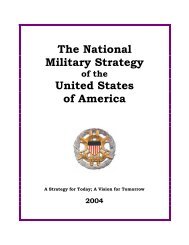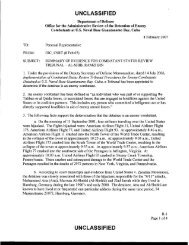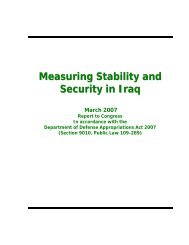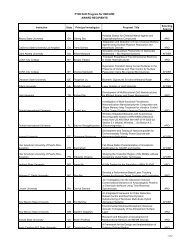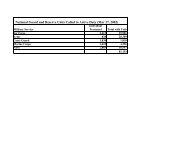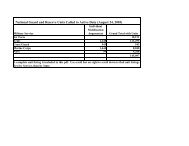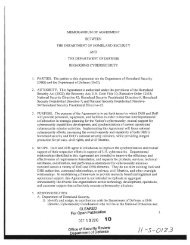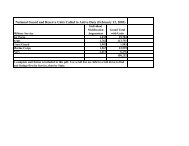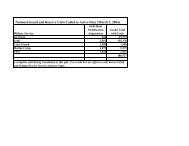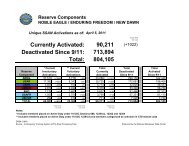Report - United States Department of Defense
Report - United States Department of Defense
Report - United States Department of Defense
Create successful ePaper yourself
Turn your PDF publications into a flip-book with our unique Google optimized e-Paper software.
UNCLASSIFIED<br />
has three Mi17v1s and 10 Mi-17v5s on loan from the Afghan Air Force. The remaining 17 Mi-<br />
17s are in overhaul or awaiting disposition.<br />
SMW development and training continues to include building night vision goggle (NVG)<br />
aircrew capacity, staff development, unit command and control (C2) battle tracking capability<br />
and preparation <strong>of</strong> the Wing HQ for activation <strong>of</strong> the Special Operations Aviation Squadrons.<br />
The SMW NVG capability now includes five full Afghan crews. The unit conducted several<br />
Afghan-planned, led and fully executed NVG missions in support <strong>of</strong> MoI and MoD taskings.<br />
The SMW has begun to increase its operational situational awareness by establishing a<br />
Situational Awareness Room (SAR) at the Wing HQs in order to track daily unit status and to<br />
conduct limited battle tracking. The HQs was issued 30 Afghan National Tracking System<br />
(ANTS) devices, which allow the tracking <strong>of</strong> aircraft operating throughout the battle space. The<br />
SAR will become fully operational once the SMW receives its ground communications<br />
equipment and is accessed into the MoD and MoI networks. The SMW's growth remains on<br />
track with the Wing HQ expected to be at Initial Operational Capability (IOC) along with the<br />
activation <strong>of</strong> the 1st Squadron by spring 2013.<br />
International and Interagency Counternarcotics Efforts<br />
Several interagency and international organizations support CN operations in Afghanistan,<br />
including the Interagency Operations and Coordination Center (IOCC), CJIATF-Nexus, and the<br />
Joint Narcotics Analysis Center (JNAC).<br />
The IOCC provides intelligence and operational support to law enforcement CN operations in<br />
Afghanistan. The IOCC, led by the DEA and <strong>United</strong> Kingdom’s Serious Organized Crime<br />
Agency (SOCA), is the central CN cell for developing an understanding <strong>of</strong> how the Afghan and<br />
regional narcotics trade supports the insurgency and drives corruption. The IOCC partners with<br />
ISAF and other CJIATF-A organizations such as CJIATF-Shafafiyat and CJIATF-Nexus to<br />
conduct law enforcement CN operations in non-secure, predominately military environments,<br />
while bringing together the necessary resources to conduct an effective civil-military campaign<br />
to counter the narcotics-corruption-insurgent nexus.<br />
CJIATF-Nexus, an ISAF organization with representatives from the international law<br />
enforcement community, also supports interdiction operations to counter the narcoticscorruption-insurgent<br />
nexus. CJIATF-Nexus specifically targets network functions (e.g., safe<br />
havens, movement, communications, and finance), rather than individual traffickers, in order to<br />
disrupt network resiliency. CJIATF-Nexus improved and expanded its narcotics targeting<br />
support during the reporting period, providing support for law enforcement investigations and<br />
military operations by analyzing key trafficking networks and improving visibility on<br />
powerbroker corruption in RC-S, RC-SW, RC-W, and RC-E.<br />
The U.S. and UK Joint Narcotics Analysis Center (JNAC) continued to perform strategic-level<br />
analysis. JNAC’s mission is to provide strategic counter-narcotics policy and operational<br />
decision-makers with independent, accurate all-source intelligence on the Afghan and wider<br />
regional drug trade, and to evaluate the potential and actual effectiveness <strong>of</strong> CN strategies and<br />
operations.<br />
150



